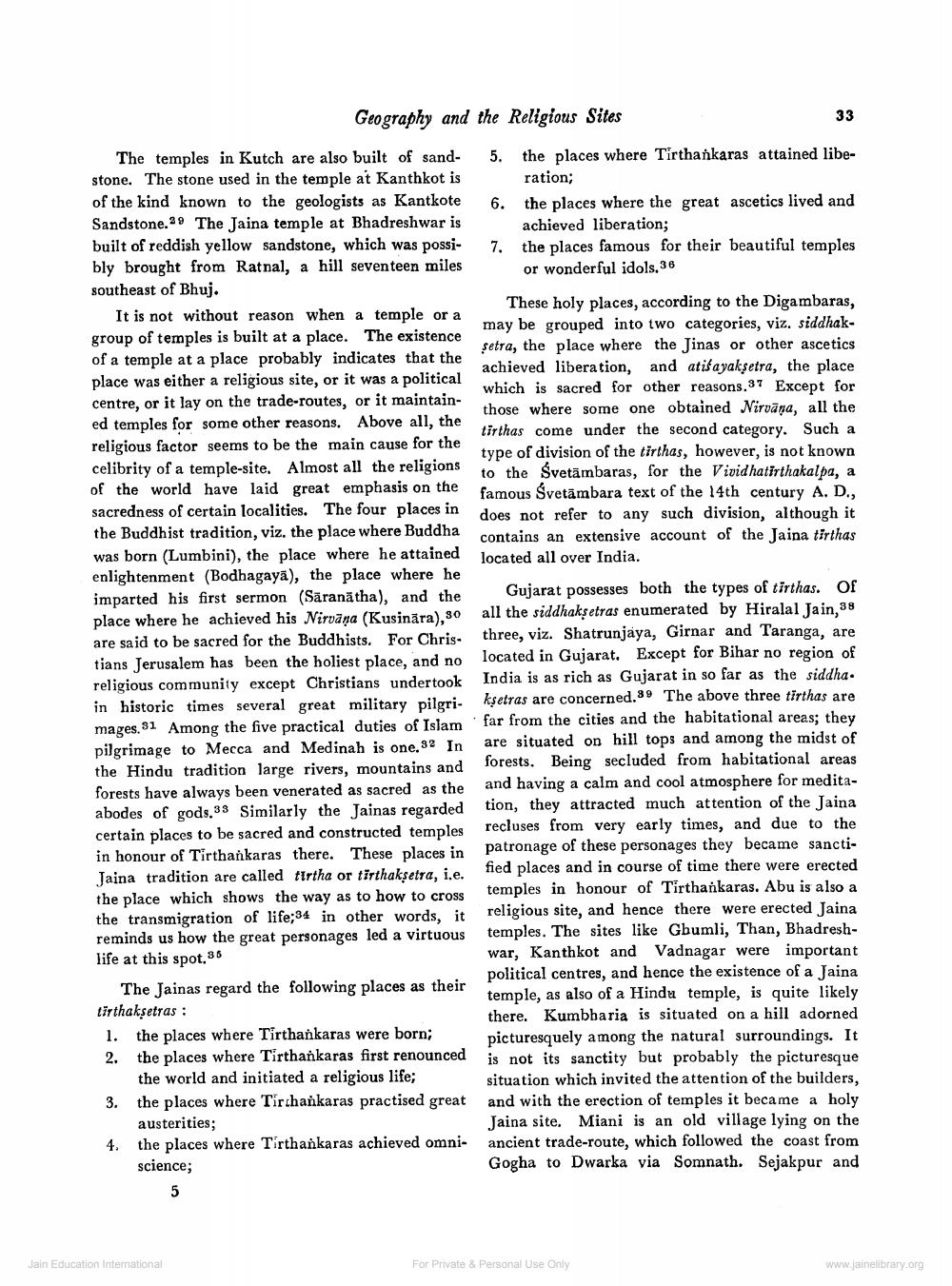________________
Geography and the Religious Sites
33
5.
6.
the places where Tirthankaras attained liberation; the places where the great ascetics lived and achieved liberation; the places famous for their beautiful temples or wonderful idols. 36
7.
The temples in Kutch are also built of sand- stone. The stone used in the temple at Kanthkot is of the kind known to the geologists as Kantkote Sandstone.29 The Jaina temple at Bhadreshwar is built of reddish yellow sandstone, which was possibly brought from Ratnal, a hill seventeen miles southeast of Bhuj.
It is not without reason when a temple or a group of temples is built at a place. The existence of a temple at a place probably indicates that the place was either a religious site, or it was a political centre, or it lay on the trade-routes, or it maintained temples for some other reasons. Above all, the religious factor seems to be the main cause for the celibrity of a temple-site. Almost all the religions of the world have laid great emphasis on the sacredness of certain localities. The four places in the Buddhist tradition, viz. the place where Buddha was born (Lumbini), the place where he attained enlightenment (Bodhagaya), the place where he imparted his first sermon (Saranatha), and the place where he achieved his Nirvana (Kusināra),30 are said to be sacred for the Buddhists. For Chris. tians Jerusalem has been the holiest place, and no religious community except Christians undertook in historic times several great military pilgri- mages. 31 Among the five practical duties of Islam pilgrimage to Mecca and Medinah is one. 32 In the Hindu tradition large rivers, mountains and forests have always been venerated as sacred as the abodes of gods 33 Similarly the Tainas regarded certain places to be sacred and constructed temples in honour of Tirthankaras there. These places in
Taina tradition are called tirtha or tirthaksetra. i.e. the place which shows the way as to how to cross the transmigration of life;34 in other words, it reminds us how the great personages led a virtuous life at this spot.36
The Jainas regard the following places as their tirthaksetras : 1. the places where Tirthankaras were born; 2. the places where Tirthankaras first renounced
the world and initiated a religious life; 3. the places where Tirchankaras practised great
austerities; 4. the places where Tirthankaras achieved omni-
science;
These holy places, according to the Digambaras, may be grouped into two categories, viz. siddhakşetra, the place where the Jinas or other ascetics achieved liberation, and atif ayaksetra, the place which is sacred for other reasons.37 Except for those where some one obtained Nirvana, all the tirthas come under the second category. Such a type of division of the tirthas, however, is not known to the Svetāmbaras, for the Vividhatirthakalpa, a to the Suatāmharas. for the v famous Svetāmbara text of the 14th century A. D., dome not refer does not refer to any such division, although it contains an extensive account of the Jaina tirthas located all over India.
Gujarat possesses both the types of tirthas. Of all the siddhaksetras enumerated by Hiralal Jain,38 three, viz. Shatrunjaya, Girnar and Taranga, are located in Gujarat. Except for Bihar no region of India is as rich as Gujarat in so far as the siddha. ksetras are concerned.89 The above three tirthas are far from the cities and the habitational areas; they are situated on hill tops and among the midst of forests. Being secluded from habitational areas and having a calm and cool atmosphere for meditation, they attracted much attention of the Jaina recluses from very early times, and due to the patronage of these personages they became sanctified places and in course of time there were erected temples in honour of Tirthankaras. Abu is also a religious site, and hence there were erected Jaina temples. The sites like Gbumli, Than, Bhadreshwar, Kanthkot and Vadnagar were important political centres, and hence the existence of a Jaina temple, as also of a Hindu temple, is quite likely there. Kumbharia is situated on a hill adorned picturesquely among the natural surroundings. It is not its sanctity but probably the picturesque situation which invited the attention of the builders, and with the erection of temples it became a holy Jaina site. Miani is an old village lying on the ancient trade-route, which followed the coast from Gogha to Dwarka via Somnath. Sejakpur and
Jain Education International
For Private & Personal use only
www.jainelibrary.org




